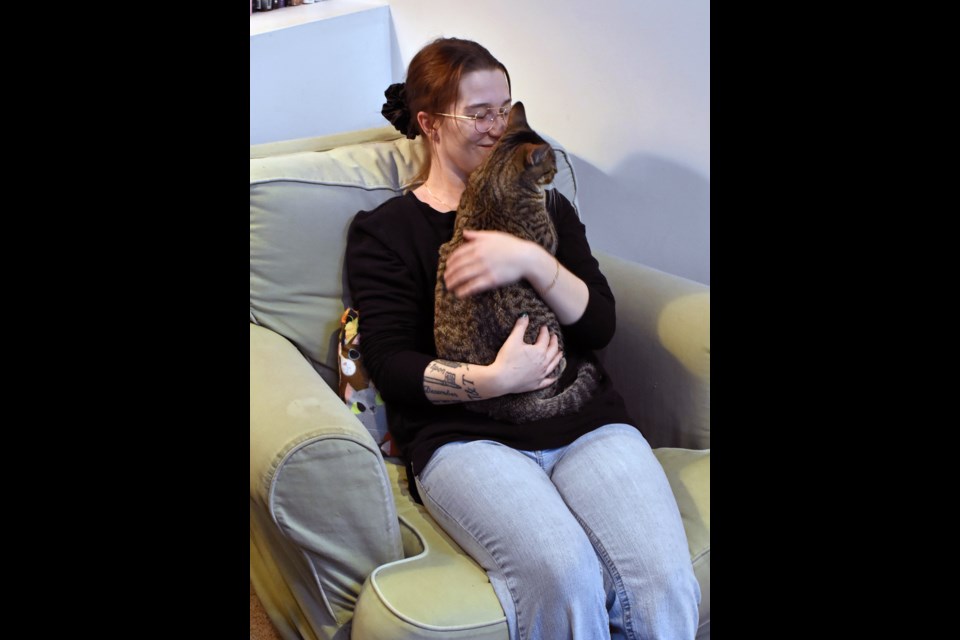SASKATOON — Sydney Sylvester has decided to share tips for cat owners, old and new, on how to take care of them properly. From nutrition, what foods to avoid for people who have cat allergies to how to introduce your furry friends to other pets — cats or dogs — little things that she learned to be effective after owning four cats.
Sylvester and her boyfriend Casey own The Purrfect Cup Café at 142 – 2nd Ave. S. downtown in Saskatoon. It has been in operation for seven months since opening its doors to cat lovers in May of this year. They are also in partnership with the Battlefords Humane Society, where they accept donations from people — monetary or food — and send them to the pet rescue centre.
“We give out pamphlets to people adopting their second or third cat. To help them introduce a new kitty at home. We have flyers and pamphlets around the café that range from grooming tips, how to help stray kitties, and the importance of spaying and neutering,” Sylvester told SASKTODAY.ca.
She even suggests particular types of cat food for people who are allergic to cats but still want to own and take care of one. People with cat allergies are also welcome to hang out at the café if they have Reactine, Epipen (Epinephrine autoinjector), or any other anti-allergy medication.
A sticky protein called Fel D1, usually on the saliva or oil glands of cats, causes an allergic reaction in humans. Fel D1 spreads when cats shed their fur and are dispersed into the surroundings through grooming. People’s bodies also produce immunoglobin (a class of proteins) to counter the cat allergen Fel D1.
“I have this running joke: I will get a gumball machine and put little packets of reactant in it for people with cat allergies. It would be best if you had a quarter, put it inside the machine, and out goes a Reactine, Benadryl, or any anti-allergy medication,” said Sylvester, who has Casey and five other staff helping out in the café’s operations.
“One thing that we do tell people with allergies is there are types of cat food you can buy, and it is specially formulated to inhibit a protein in the cat’s saliva that makes them [cats] walking allergy balls. So, that’s an option for people with allergies who still want to own a cat. They are also developing a vaccine for cats to do the same thing as the food.”
She added that the developed vaccine would make cats no longer produce the Fel D1 protein that causes allergens. She said it is also essential that cat owners make sure the food that they are going to buy has signs that prevent the production of the Fel D1 protein.
“It must be continuous. It would be best if you fed your cat that particular food because once you stop feeding that particular food brand, the cat will again start producing the [Fel D1] protein. As soon as you stop, the cat will again become an allergen as time goes by,” added Sylvester, who adopted her first cat when she was 10.
A helping paw
Sylvester said they only assist people in adopting the cats whose photos are posted on a board inside the café, on the BHS website, and through social media. She added that they could answer all inquiries on how to adopt a cat, but BHS would still handle the application process.
“We have seen many cats brought here at the café — people looking for places to leave their cats. Unfortunately, we are not equipped like a shelter. We can not also take stray cats or people who want to surrender cats, but we give them as many avenues as we can, like which shelter or animal rescue organization they can go to,” said Sylvester.
“If they found a cat through social media, or maybe they want to rehome a cat, we have resources for people to go to. We also partnered with Better Paws, offering free behavioural, nutrition and veterinary advice to minimize how many animals may return to the shelter because of medical and behavioural issues.”
She added that they have somewhat become an information desk, offering a helping hand or in this case a helping paw, where they give people the best advice that would help them decide on how to take care of their cats properly or tell them the organizations or groups depending on what they need — whether adopting, rehoming, or if they find a stray or lost cat.
They also accept donations — monetary, food, and other cat-related care items — that they give to BHS, including the paw prints that they are selling to help the fundraising efforts of the group in building a new shelter to house the animals, cats, and dogs, that are currently under their care.
“The money goes straight to them [BHS]. One hundred percent of the proceeds [paw prints] go to [BHS]. We also take cash donations for our kitties here at the café. We chose to buy cat towers, toys, and kitty litter. We just ordered a big cat wheel; it’s like a hamster wheel for them to play with,” said Sylvester.



